![]()
![]()
THE PLACE OF ARMENIA AND THE ARMENIAN
LANGUAGE
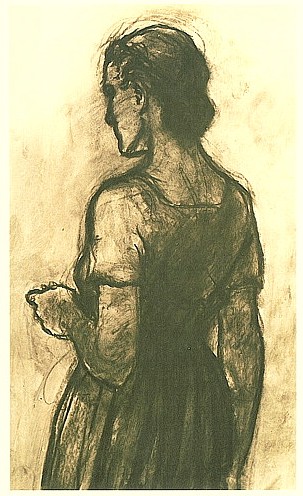
by Thomas V. Gamkrelidze and V. V. Ivanov
Scientific American, March 1990, P.110
This inference is supported by what is known about the portion of the Indo-European community that remained after the Anatolian family had broken away. From that community came the languages that persisted into written history. The first to branch off was the Greek-Armenian-Indo-lranian language community. It must have begun to do so in the fourth millennium B.C. because by the middle of the third millennium B.C. the community was already dividing into two groups, namely, the Indo-lranian and the Greek-Armenian. Tablets in the Hattusas archives show that by the middle of the second millennium B.C. the Indo-lranian group had given rise to a language spoken in the Mitanni kingdom on the southeast frontier of Anatolia that was already different from ancient Indian (commonly called Sanskrit) and ancient Iranian. Cretan Mycenaean texts from the same eras as Mitanni, deciphered in the early 1950's by the British scholars Michael G. F. Ventris and John Chadwick, fumed out to be in a previously unknown dialect of Greek. All these languages had gone their separate ways from Armenian.
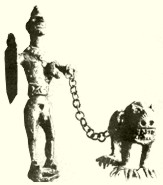
STATUETTE OF AN ARMENIAN WARRIOR
WITH 'MAN'S BEST FRIEND'
SECOND MILLENNIUM BC

PIN - MACROCOSM + MICROCOSM.
INFINITI VISHAP/ORUBOROS WITHIN
AND WITHOUT 'CRACKING' THE COSMIC EGG.
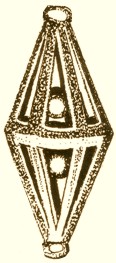
RHOMBUS OF DIVINITY FROM LORIBERD.
SECOND MILLENNIUM BC.
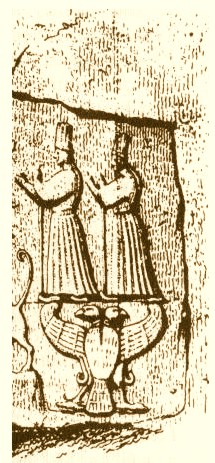
HITTITE RELIEF SHOWING THE TWO HEADED EAGLE
WITH ITS TWO WINGS SYMBOLICALLY SUPPORTING THE TWO PRIEST-KINGS.
THE HITTITES WERE KINSMEN OF NEIGHBORING INDO-EUROPEAN HAYASAS
WHO IN THE SECOND MILLENNIUM BC FORMED A POWERFUL KINGDOM
ENCOMPASSING MUCH OF THE ORIGINAL INDO-EUROPEAN HOMELAND
[BELOW MAP].
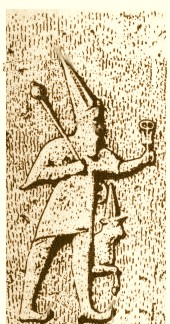
Tocharian was another language family that diverged from the Indo-European protolanguage quite early. Tocharian is one of the more recently discovered Indo-European languages, first recognized in the early decades of the 20th century in texts from Chinese Turkestan. The texts were comparatively easy to decipher because they were written in a variant of the Brahmi script and were mainly translations from known Buddhist writings.
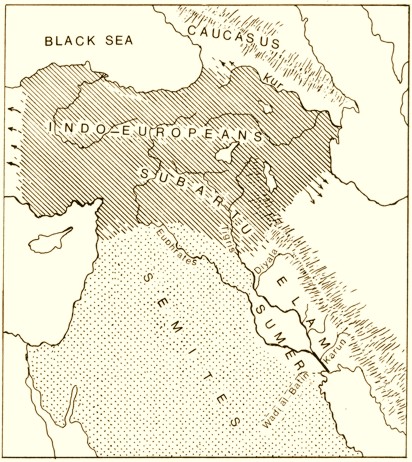
A R M E N I A N H I G H L A N D. I
N D O - E U R O P E A N H O M E L A N D.
Not long ago, the British scholar W. N. Henning suggested that the Tocharians be
identified with the Gutians, who are mentioned in Babylonian cuneiform
inscriptions (in Akkadian, a Semitic language) dating from the end of the third
millennium B.C., when King Sargon was building the first great Mesopotamian
Empire.
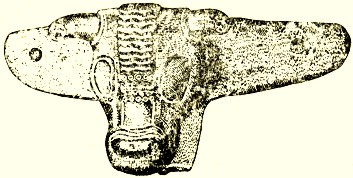
CELESTIAL BULL/HOLY COW
![]() .
.
HANDLE FROM A CEREMONIAL POT USED FOR SACRED RITUALS.
THE OBSERVATION OF THE CONSTELLATION OF TAURUS
WAS AN IMPORTANT ELEMENT IN THE ASTRONOMICAL
STUDIES OF THE ARMAN HIGH PRIESTS.

A R M A N DECORATED SWORDS [a AND b] WITH THE SYMBOL
OF O R I O N...
DAGGER [c] -- HANDLE IN THE FORM OF TWO
EAGLES FACING OPPOSITE DIRECTIONS WITH A COUNTERCLOCKWISE
SWASTIKA IN THE CENTER ALONG WITH TRIANGLES POINTING
TO THE FOUR CARDINAL DIRECTIONS. DECORATED DAGGER SHEAF [d] --
GOD-MAN WITHIN THE COSMIC MOUNTAIN -- FLANKED
BY TWO SWASTIKAS SPINNING INTO OPPOSITE DIRECTIONS.
WARRIOR'S BELT [e] -- COSMIC WHEEL IN THE CENTER WITH A GOAT
AND SPIRALS [SYMBOLS OF SOLAR RAM] SPINNING -- RIGHT AND LEFT
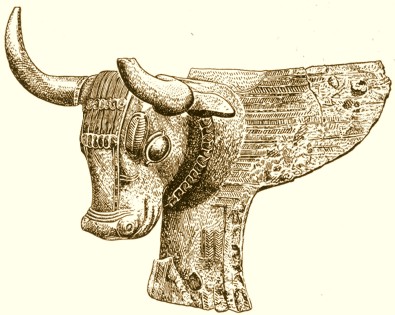
ANOTHER EXAMPLE OF THE BRONZE HEAD OF A BULL
THAT SERVED AS A HANDLE OF A HUGE CEREMONIAL
CAULDRON. FROM TOPRAK KALE ON DISPLAY IN
THE BRITISH MUSEUM.
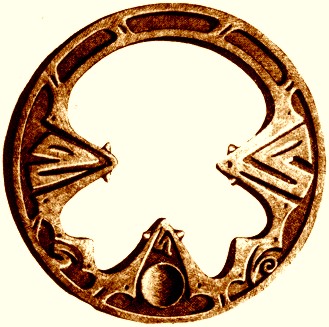
SACRED OJAKH [HEARTH] FROM
ŠENGAVIT‛
THAT KEPT THE SACRED FLAME BRINGING
WARMTH AND LIGHT AND ILLUMINATING THE HOME.
SECOND MILLENNIUM BC.
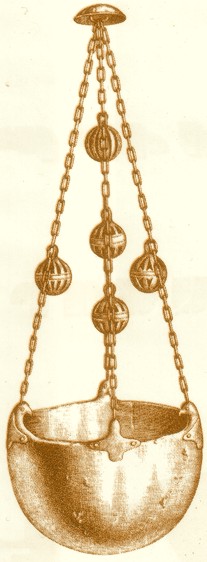
BRONZE BURVAR [LIT. SCENT BURNER]. XVTH CENTURY BC. FOUR
WINGED
BIRDHEADS AT FOUR CARDINAL POINTS. THE CHAIN IN THE CENTER
HAS FOUR SPHERES [WITH TOP LOOPS FORMING 8...WITH
THE
MERIDIAN/HORIZON GOING ACROSS THE CENTER...NOTE THE SPHERE
ON THE RIGHT WITH CHALDEAN UP AND DOWN POINTING [FISH TAIL] CUNEIFORMS
UNITED TOGETHER FORMS THE MALTESE [EA] CROSS. THE FIFTH QUINTESSENTIAL
[MADE UP OF VERTICALLY ALIGNED CRESCENT SHAPES...SIM. CARVINGS WERE MADE
ON ORANGE PUMPKINS DURING THE BELTANE CARRIED OVER TO HALLOWEEN]
SPHERE ON TOP...THE HOLY VESSEL USED FOR BURNING EXTRACT ESSENCES
FROM SELECTED HOLISTIC PLANTS, [CONSUMED] VEGETABLES AND ESPECIALLY
SACRED [SHAMANIC] MUSHROOMS. XUNK THE DISTINCT WAX IMBUED WITH
THE SUBLIME SCENTS [HARMONIOUS FRAGRANCE CONNECTED WITH OTHER
SENSES.. AND... WITH ESSENCE] IS USED TO THIS VERY DAY DURING THE
SACROSANCT RITUALS HELD BY THE ARMENIAN HOLY APOSTOLIC CHURCH,
AS WELL AS BURNED AT THE TOMBS AND SHRINES OF DEPARTED ANCESTORS BY
THE MEMBERS OF THE FAMILY...
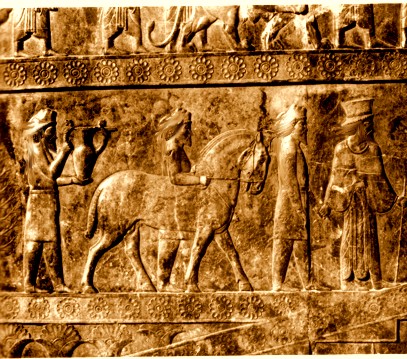
ARMENIANS DEPICTED WITH THEIR PRIZED STEEDS WEARING DISTINCTIVE
NATIONAL MITHRAIC RED CAPS AND WHITE TUNICS. FROM THE RELIEFS OF THE
APADANA [PALACE] IN PERSEPOLIS. VITH CENTURY BC.
If Henning's views are correct, the Tocharians would be the first Indo-Europeans to appear in the recorded history of the ancient Near East. Lexical affinities of Tocharian with Italo-Celtic give evidence that the speakers of the two language families had associated in the Indo-European homeland before the Tocharians began their migration eastward. The diverging pathways of linguistic transformation and human migration may now be traced back to a convergence in the Indo-European protolanguage and its homeland. This has followed from the revision in the canons of phonology we mentioned above.
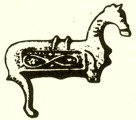
FIGURINE OF A HORSE FROM THE METSAMOR DIG. SECOND MILLENNIUM B.C.
NOTE THE ANCIENT ARMENIAN SIGN OF INFINITI,
SOMETIMES REFERRED AS THE 'LAZY 8'.
FOUR DOTS SYMBOLIZE THE FOUR CARDINAL POINTS [HORSEMAN'S JOURNEY]
ALONG WITH THE EIGHT CARDINAL DIRECTIONS

FINELY MADE DECORATIVE GILDED BUTTONS -- PART OF PRIZED
STEEDS OVERALL
DECORUM. THE BUTTONS ARE EMBLEMATICALLY ADORNED WITH TWO SEVEN [77]
POINTED STARS LEADING TO THE INNER CIRCLE WITHIN A CIRCLE.
METSAMOR. BEGINNING OF FIRST MILLENNIUM BC.
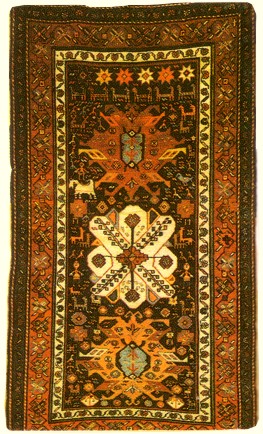
DECORATIVE SADDLE CARPETS ADORNED WITH
RIDER'S HORSES AND THE EIGHT POINTED [FIVE PROMINENTLY
DISPLAYED ABOVE + 3 CENTRAL-CRUX INCLUDING THE TWIN-HEADED
DRAGONS ABOVE AND BELOW THE OCTAVE] STAR [EIGHT
CARDINAL DIRECTIONS...AND...ETERNITY...SPACE AND TIME..
ENERGY AND MATTER...] ALONG WITH A HOST OF OTHER
KEY SYMBOLIC MARKINGS.
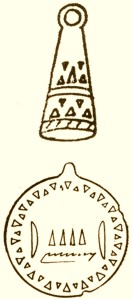
MAGICK MEDALLION AND CHARM.
ENOK'AVAN. SECOND MILLENNIUM BC.

ARMAN BRACELET. SECOND MILLENNIUM BC.
An uncontested peculiarity of the sound system of the protolanguage, for example, is the near absence, or suppression, of one of the three consonants "p," "b" or "v," which are labials (consonants sounded with the lips). Traditionally, it had been thought that "b" was the suppressed consonant. Subsequent studies in phonology indicated, however, that if one of the three labial consonants is lacking in a language, it is least likely to be the one sounded as "b" in English and other living European languages.
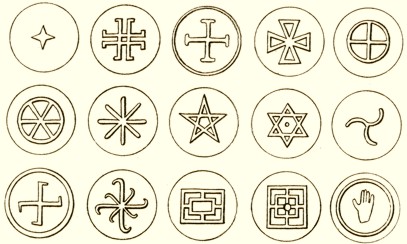
SOME OF THE TALISMANS OF PROTECTION AND CLAN RECOGNITION
WORN BY AR-MEN-IC WARRIORS FOUND THROUGHOUT NUMEROUS BURIAL MOUNDS

STATUETTES OF WOLVES FROM A Y R U M [MAN-FIRE].
FIRST MILLENNIUM BC.
On that basis we decided to reexamine the entire system of consonants posited
for the protolanguage, and as early as 1972, we proposed a new system of
consonants for the language. Our proposal remains in the crucible of debate from
which consensus forms in every science. The debate now focuses more strongly on
features that relate the Indo-European protolanguage to other major language
families and that have at last begun to bring their common ancestor into view.
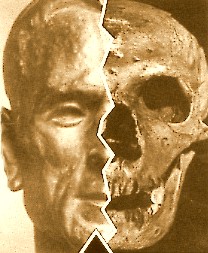
ONE OF THE RECONSTRUCTED CRANIUMS
According to classical theory, the "stop" consonants—those that are sounded by interruption of the outward flow of the breath that excites the vibration of the glottis, or vocal cords—are divided into three categories [see top of illustration on this page]. The labial stop consonant "b" appears in the first column as a voiced consonant; the parentheses enclosing it there indicate its supposed suppression. It is associated with two other voiced stop consonants: "d" (stopped by the forward part of the tongue against the palate) and "g" (stopped by the back of the tongue against the palate).

BATTLE AXE FROM SIWNIK‛ [SYUNIK].
SECOND MILLENNIUM BC.
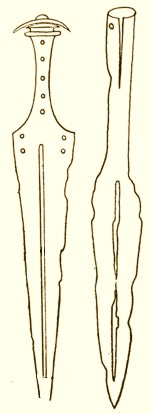
ENOK‛AVAN. DAGGER
AND A SPEARHEAD.
SECOND MILLENNIUM BC.

ITEMS WITH SACRED SYMBOLISM FROM
ŠIRAK
BURIAL TOMBS. SOLAR AMULETS [RIGHT AND LEFT SPIRALS WITHIN
THE CIRCLE AND THE CROSS, NINE-SPOKE WHEEL], LOVEBIRDS
[DUALITY, PRIMORDIAL FIRST COUPLE...NOTE UP AND DOWN TRIANGLES],
ARMLET WITH WRAPPING REEFS [ACTIVITY/VICTORY/GLORY].
DIAMONDS/RHOMBI/TRIANGLES ARRANGED IN A HEXAGONAL PATTERN,
SIM. TO THE DJET PILLAR IN EGYPT WITH FIVE [4+1] LAYERED NOTCHES...
SECOND MILLENNIUM BC.
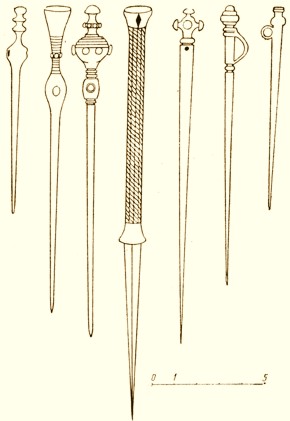
SUPERBLY EXECUTED BRONZE PINS AND NEEDLES
FROM ŠIRAK. SECOND MILLENNIUM BC.
In the scheme we have developed, the corresponding consonants are sounded with a glottalized stop: a closure of the throat at the vocal cords that prevents the outward flow of breath. Here the voiceless labial stop ("p"') appears suppressed, followed by "t"' and "k'." As ("p"') is to ("b"), voiceless and voiced, respectively, so "t"'is to "d" and "k"'is to "g." Glottalized stops occur in many different language families, particularly those of northern Caucasian and southern Caucasian ( Kartvelian ) provenance. The glottalized stop—which hardens a consonant—tends to weaken and disappear in most languages of the world. So we surmised that—among the labial stops—it was the "p" rather than the "b" that most likely had been suppressed in the Indo-European pro t o language .
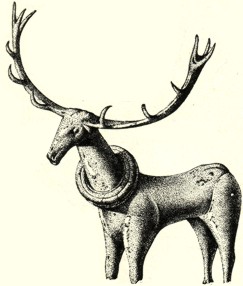
STATUETTE OF A DEER FROM TOLORS.
SECOND MILLENNIUM BC.

Our so-called Indo-European glottalic system, which has been constructed by
comparing the phonology of the living and the historically attested
Indo-European languages, appears more probable than the classical one. The near
absence of the labial phoneme ("p"') finds a natural phonological explanation in
relation to the evolution of the other two glottalized stops and to the entire
system of stops shown above.

ARMENIC WOMAN
THIRD MILLENNIUM BC
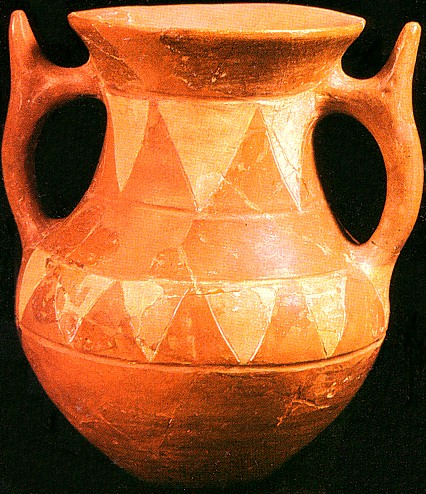
CLAY KARAS DECORATED WITH UP + DOWN TRIANGLES. VESSEL [FEM. BODY]
WITH
EXTENDED [HORN] HANDLES. EREBUNI [ARYN BERD]. VII-VITH CENTURIES BC.
In revising the consonant system of the Indo-European protolanguage, we have also called into question the paths of transformation into the historical Indo-European languages. Our reconstruction of the protolanguage's consonants shows them to be closer to those of the Germanic, Armenian and Hittite daughter languages than to Sanskrit. This neatly reverses the classical conception that the former languages had undergone a systematic sound shift, whereas Sanskrit had faithfully conserved the original sound system.
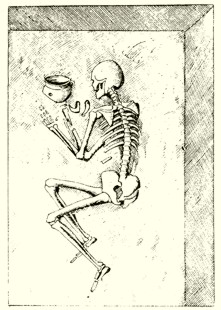
A RECTANGULAR GRAVE OF AN ARMENIC MAN WITH A
RITUALISTIC JAR AND DECORATIONS. DARANI [ABOVIAN], SECOND MILLENNIUM BC.
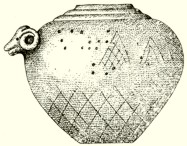
RAM'S HEAD ON A DECORATED POT.
VANADZOR. SECOND MILLENNIUM BC.
The transformation of consonants from parent to daughter languages may be illustrated by the word "cow" in English and Kuh in German; in Sanskrit the word for "ox" is ganh, and in Greek it is bous All have long been recognized as descending from a common Indo-European word for "ox," or "cow."
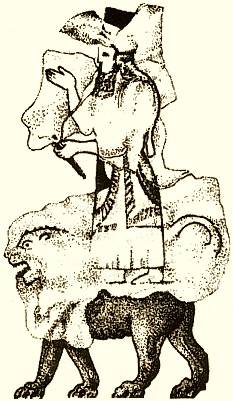
[K]HALDI THE SUPREME GOD OF THE HOLY TRIAD.
ON TOP OF THE LION [SYMBOL OF PARAMOUNT LORDSHIP].
A FRESCO FROM THE ARYN-BERD HILL -- ĒREBUNI-ĒREVAN.
THE K‛URMS -- THE ARMAN HIGH PRIEST ASTROLOGERS
CALLED THEMSELVES
[K]HALDEANS AFTER THE GOD OF THE ASTRAL LIGHT.
ALL ARE MANIFESTATIONS OF EA-[H]AYA [DIVINE ESSENCE].
The word has different forms, however, in the glottalic and classical systems. In the glottalic it has the voiceless consonant *k'Wou- (the asterisk before a word designates it as a word in the protolanguage), which makes it phonetically closer to the corresponding words in English and German than to those in Greek and Sanskrit.

T E I Š E B A [SYMB. BULL]
![]()
THE GOD OF
LIGHTNING AND THUNDER
HOLDING THE CELESTIAL HAMMER OF DESTINY.
ALONG WITH THE SUN GOD
Š I V I N I [SYMB. EAGLE] AND
H A L D I [SYMB. LION] THE SUPREME GOD OF PROVIDENCE
COMPLETES THE HOLY TRIAD OF ARARAT'S EXOTERIC PANTHEON.
ALL ARE CELESTIAL SKY GODS ASSOCIATED WITH ASTRAL LIGHT.
In the classical system the word is *gwou, which is practically the same as that
in Sanskrit. In accordance with Grimm's law, the transformation of *gwou to the
German would require devoicing of the first consonant from "g" to "k." And so
the glottalic system seems to make the most sense: it eliminates the need for
devoicing and correlates the voiceless stops in the Germanic languages (German,
Dutch, Scandinavian and English) with voiceless glottalized stops in the
ancestral Indo-European protolanguage. In this respect the Germanic languages
are more archaic than Sanskrit and Greek. The glottalic system is seen,
correspondingly, as more conservative than the classical system. It has brought
the protolanguage closer to some of its daughter languages without resorting to
such difficult phonological transformations as that from "g" ta "k."
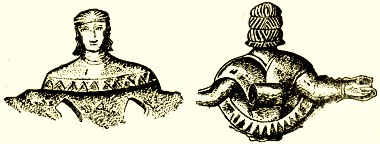
AR AR AT.
STATUETTE OF THE SUN GOD
Š I V I N I.